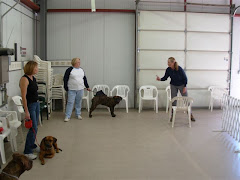Which are you? Proactive or reactive?
Let's say your dog has a habit of lunging aggressively toward other dogs when in a class or other public situation.
You correct him with a stern voice and strong physical correction AFTER he lunges. If this is your style, you are a "reactive" handler.
A "proactive" handler is one who is very aware of her dog's tendency, and works to maintain good behavior so that she won't have to correct the dog for lunging. In other words, while the dog is quiet and well behaved, she is nuturing that behavior by acknowledging it. Her acknowledgment should actually carry the tone of a veiled threat: "Goooood boy, LEAVE it! Good leave it, quiet, right here, watch me, leave it, leave it," etc.
We all want our dogs to be naturally good and nice in public. We want to forget their tendencies to lunge, snarl and bark, and enjoy the moments of peace and good behavior. That's why we tend to clam up and ride the good behavior until we fall off, and then correct the dog for his social blunder. The problem is, the dog isn't going to learn self control if we are only reactive to the dog's mistakes. By the time your dog is ready to lunge at another dog, he's in the "red zone," as Cesar Millan would say. He's already crossed the mental line between self-controlled obedient pet and raw animal with no self control. All you'll be able to do at that point is (hopefully) hold him back and try to correct him with a verbal reprimand or a leash tug. The correction, however, will be meaningless because the dog's moment of "red zone" aggression has dissipated. He probably won't even know why he's being corrected and, of he does, he'll simply consider it as acceptable consequences that are not unpleasant enough to deter him from repeating his mistake.
While you are standing around in a dog class or a competition, you are probably watching the other people and dogs, or perhaps visiting. Your dog is watching too, but often with a different motive. He's watching to see which dog he likes the least, or which one excites him the most, and he's getting ready to spring toward that dog or bark aggressively if the dog comes near. You, as handler and leader, do not have the luxury of relaxing, visiting, and studying what's going on in the other end of the classroom. Your attention must be on your dog. Give him verbal support the whole time, so he knows you're watching him...and he knows you'll "nail" him if he starts to cross the line. It's this "omnipresence" that is so powerful in controlling your dog. He must know (or think) you have eyes in the back of your head and you can read all his thoughts. Once you have convinced him of this, he will look to you with reverence instead of blowing you off. He will exercise self control instead of lunging or snarling on a whim. Why? Because he knows "Leader" (you) deserves respect and wants good behavior, and because he knows you have the power to enforce.
As your dog gets older and more experienced, you won't need to keep up your "veiled threat" in order to stop your dog from lunging and barking. Once you have truly established yourself as leader, you and your dog will have a cozy, smooth relationship in which your dog doesn't argue with you or test your fortitude. Until then, become proactive...support the good behavior with praise, so that you won't need to correct in a reactive fashion.
Questions about dog behavior and training? Send them to: sandersagility@gmail.com.
Sunday, May 2, 2010
Subscribe to:
Post Comments (Atom)



















No comments:
Post a Comment